Taxation Law: Income Tax Computation and Deductibility of Expenses
VerifiedAdded on 2023/06/11
|11
|2161
|202
AI Summary
This article discusses income taxation computation and deductibility of expenses under Taxation Law. It analyzes the impact of taxes on transactions such as winning cash prizes, appearance on television, receipts from salaries and receipts from sports events. The article also explains the rules and applications of various sections of the ITAA 1997 and FBTAA 1986. It concludes with a working note and reference list.
Contribute Materials
Your contribution can guide someone’s learning journey. Share your
documents today.
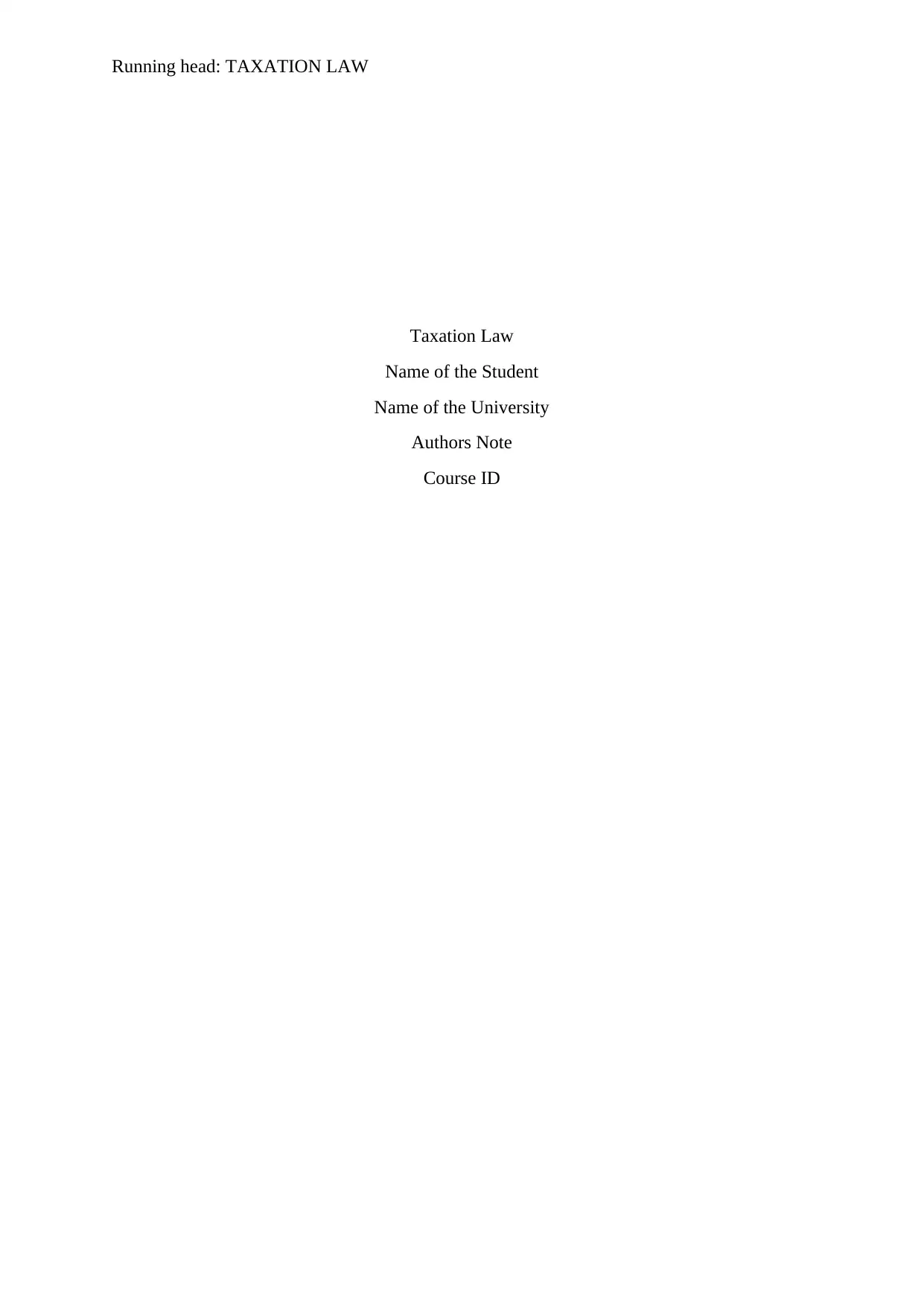
Running head: TAXATION LAW
Taxation Law
Name of the Student
Name of the University
Authors Note
Course ID
Taxation Law
Name of the Student
Name of the University
Authors Note
Course ID
Secure Best Marks with AI Grader
Need help grading? Try our AI Grader for instant feedback on your assignments.
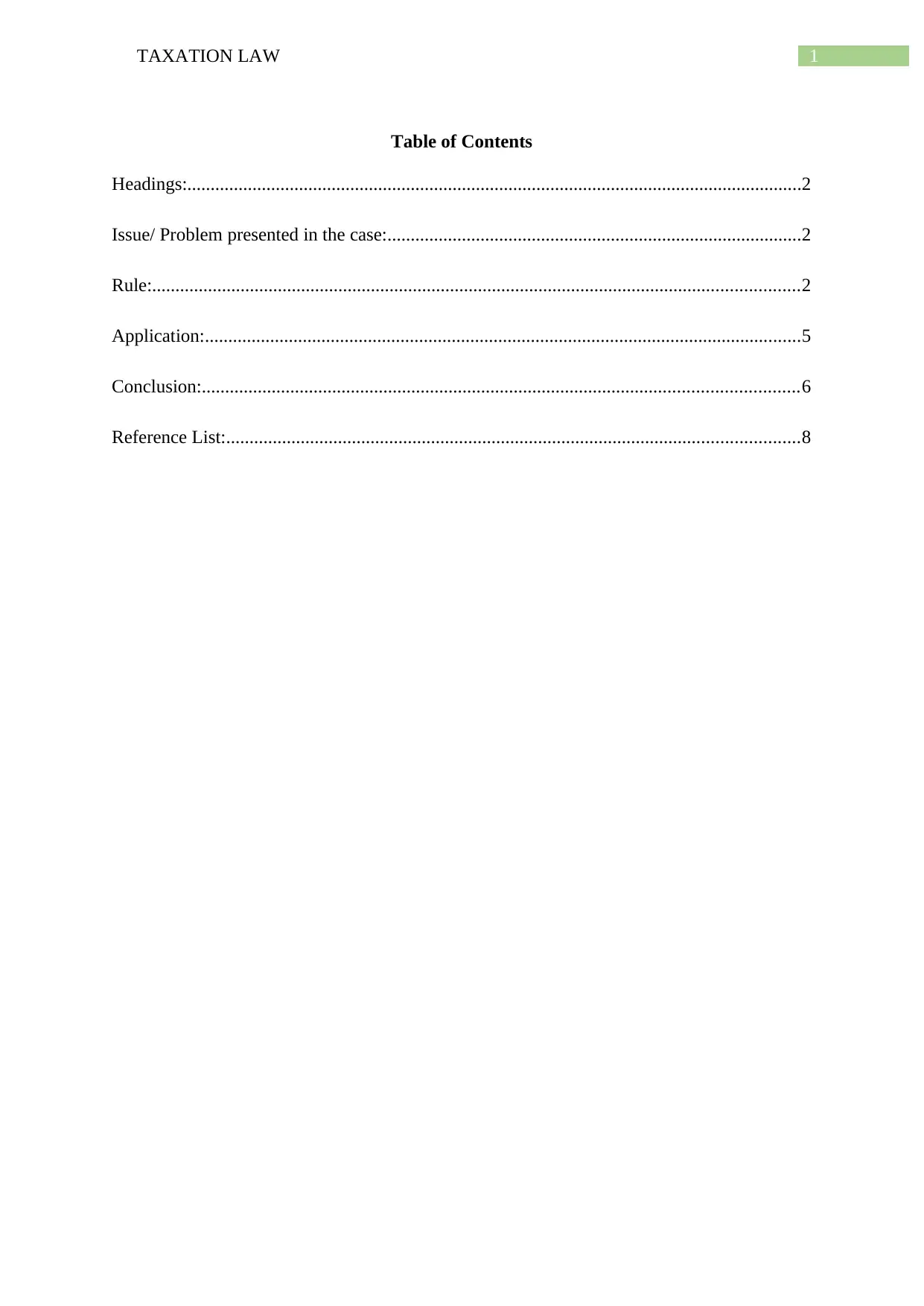
1TAXATION LAW
Table of Contents
Headings:....................................................................................................................................2
Issue/ Problem presented in the case:.........................................................................................2
Rule:...........................................................................................................................................2
Application:................................................................................................................................5
Conclusion:................................................................................................................................6
Reference List:...........................................................................................................................8
Table of Contents
Headings:....................................................................................................................................2
Issue/ Problem presented in the case:.........................................................................................2
Rule:...........................................................................................................................................2
Application:................................................................................................................................5
Conclusion:................................................................................................................................6
Reference List:...........................................................................................................................8
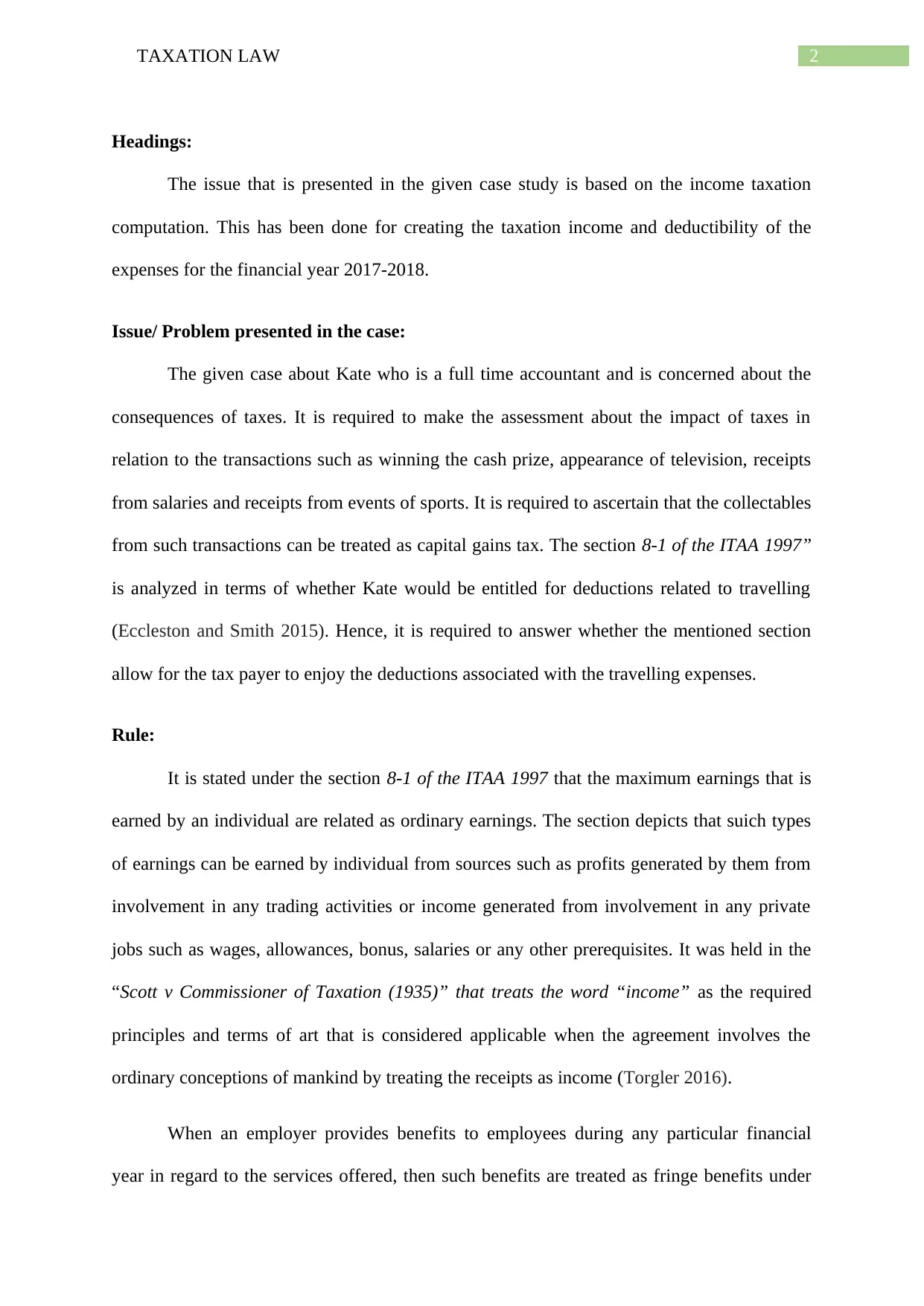
2TAXATION LAW
Headings:
The issue that is presented in the given case study is based on the income taxation
computation. This has been done for creating the taxation income and deductibility of the
expenses for the financial year 2017-2018.
Issue/ Problem presented in the case:
The given case about Kate who is a full time accountant and is concerned about the
consequences of taxes. It is required to make the assessment about the impact of taxes in
relation to the transactions such as winning the cash prize, appearance of television, receipts
from salaries and receipts from events of sports. It is required to ascertain that the collectables
from such transactions can be treated as capital gains tax. The section 8-1 of the ITAA 1997”
is analyzed in terms of whether Kate would be entitled for deductions related to travelling
(Eccleston and Smith 2015). Hence, it is required to answer whether the mentioned section
allow for the tax payer to enjoy the deductions associated with the travelling expenses.
Rule:
It is stated under the section 8-1 of the ITAA 1997 that the maximum earnings that is
earned by an individual are related as ordinary earnings. The section depicts that suich types
of earnings can be earned by individual from sources such as profits generated by them from
involvement in any trading activities or income generated from involvement in any private
jobs such as wages, allowances, bonus, salaries or any other prerequisites. It was held in the
“Scott v Commissioner of Taxation (1935)” that treats the word “income” as the required
principles and terms of art that is considered applicable when the agreement involves the
ordinary conceptions of mankind by treating the receipts as income (Torgler 2016).
When an employer provides benefits to employees during any particular financial
year in regard to the services offered, then such benefits are treated as fringe benefits under
Headings:
The issue that is presented in the given case study is based on the income taxation
computation. This has been done for creating the taxation income and deductibility of the
expenses for the financial year 2017-2018.
Issue/ Problem presented in the case:
The given case about Kate who is a full time accountant and is concerned about the
consequences of taxes. It is required to make the assessment about the impact of taxes in
relation to the transactions such as winning the cash prize, appearance of television, receipts
from salaries and receipts from events of sports. It is required to ascertain that the collectables
from such transactions can be treated as capital gains tax. The section 8-1 of the ITAA 1997”
is analyzed in terms of whether Kate would be entitled for deductions related to travelling
(Eccleston and Smith 2015). Hence, it is required to answer whether the mentioned section
allow for the tax payer to enjoy the deductions associated with the travelling expenses.
Rule:
It is stated under the section 8-1 of the ITAA 1997 that the maximum earnings that is
earned by an individual are related as ordinary earnings. The section depicts that suich types
of earnings can be earned by individual from sources such as profits generated by them from
involvement in any trading activities or income generated from involvement in any private
jobs such as wages, allowances, bonus, salaries or any other prerequisites. It was held in the
“Scott v Commissioner of Taxation (1935)” that treats the word “income” as the required
principles and terms of art that is considered applicable when the agreement involves the
ordinary conceptions of mankind by treating the receipts as income (Torgler 2016).
When an employer provides benefits to employees during any particular financial
year in regard to the services offered, then such benefits are treated as fringe benefits under
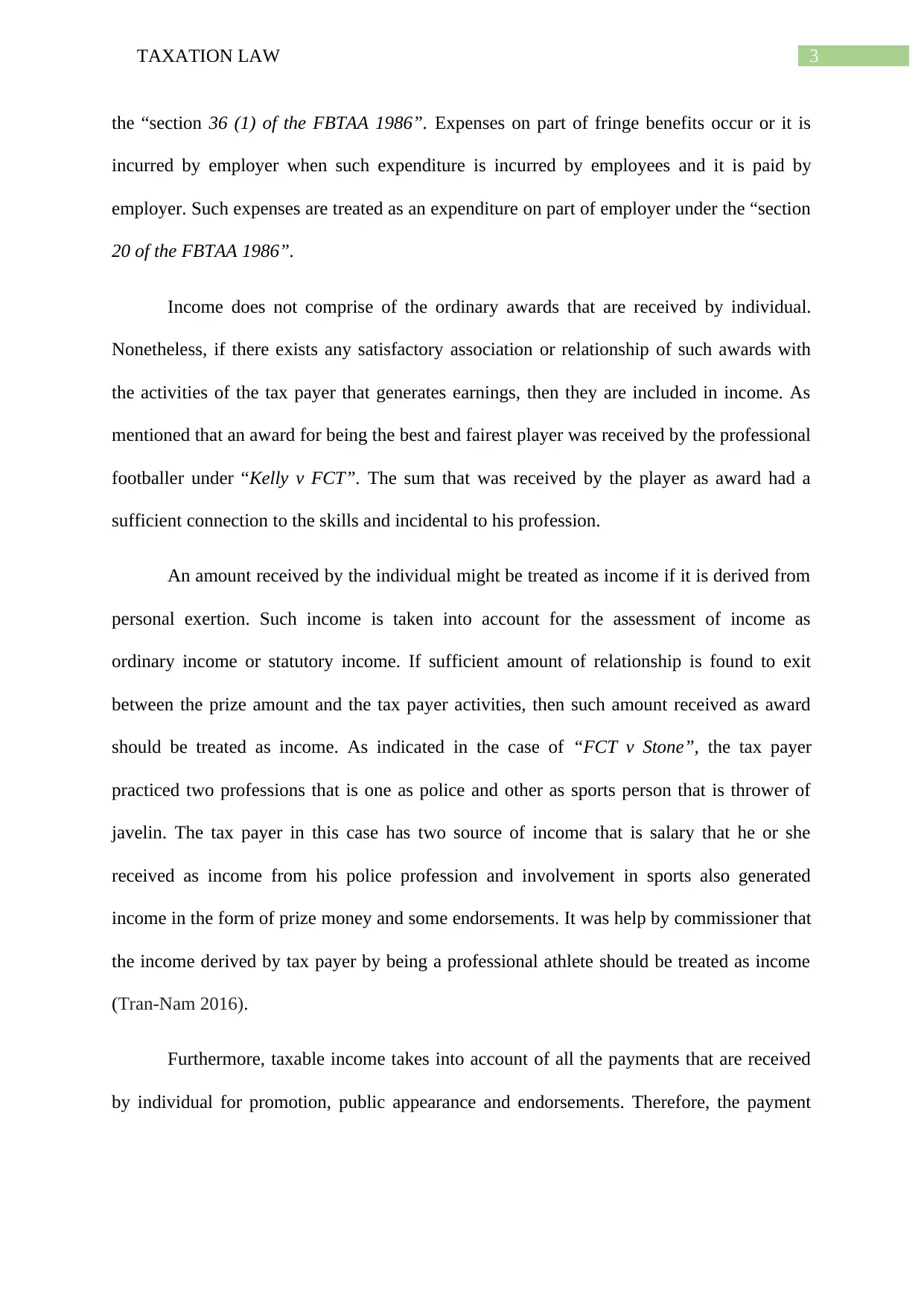
3TAXATION LAW
the “section 36 (1) of the FBTAA 1986”. Expenses on part of fringe benefits occur or it is
incurred by employer when such expenditure is incurred by employees and it is paid by
employer. Such expenses are treated as an expenditure on part of employer under the “section
20 of the FBTAA 1986”.
Income does not comprise of the ordinary awards that are received by individual.
Nonetheless, if there exists any satisfactory association or relationship of such awards with
the activities of the tax payer that generates earnings, then they are included in income. As
mentioned that an award for being the best and fairest player was received by the professional
footballer under “Kelly v FCT”. The sum that was received by the player as award had a
sufficient connection to the skills and incidental to his profession.
An amount received by the individual might be treated as income if it is derived from
personal exertion. Such income is taken into account for the assessment of income as
ordinary income or statutory income. If sufficient amount of relationship is found to exit
between the prize amount and the tax payer activities, then such amount received as award
should be treated as income. As indicated in the case of “FCT v Stone”, the tax payer
practiced two professions that is one as police and other as sports person that is thrower of
javelin. The tax payer in this case has two source of income that is salary that he or she
received as income from his police profession and involvement in sports also generated
income in the form of prize money and some endorsements. It was help by commissioner that
the income derived by tax payer by being a professional athlete should be treated as income
(Tran-Nam 2016).
Furthermore, taxable income takes into account of all the payments that are received
by individual for promotion, public appearance and endorsements. Therefore, the payment
the “section 36 (1) of the FBTAA 1986”. Expenses on part of fringe benefits occur or it is
incurred by employer when such expenditure is incurred by employees and it is paid by
employer. Such expenses are treated as an expenditure on part of employer under the “section
20 of the FBTAA 1986”.
Income does not comprise of the ordinary awards that are received by individual.
Nonetheless, if there exists any satisfactory association or relationship of such awards with
the activities of the tax payer that generates earnings, then they are included in income. As
mentioned that an award for being the best and fairest player was received by the professional
footballer under “Kelly v FCT”. The sum that was received by the player as award had a
sufficient connection to the skills and incidental to his profession.
An amount received by the individual might be treated as income if it is derived from
personal exertion. Such income is taken into account for the assessment of income as
ordinary income or statutory income. If sufficient amount of relationship is found to exit
between the prize amount and the tax payer activities, then such amount received as award
should be treated as income. As indicated in the case of “FCT v Stone”, the tax payer
practiced two professions that is one as police and other as sports person that is thrower of
javelin. The tax payer in this case has two source of income that is salary that he or she
received as income from his police profession and involvement in sports also generated
income in the form of prize money and some endorsements. It was help by commissioner that
the income derived by tax payer by being a professional athlete should be treated as income
(Tran-Nam 2016).
Furthermore, taxable income takes into account of all the payments that are received
by individual for promotion, public appearance and endorsements. Therefore, the payment
Secure Best Marks with AI Grader
Need help grading? Try our AI Grader for instant feedback on your assignments.
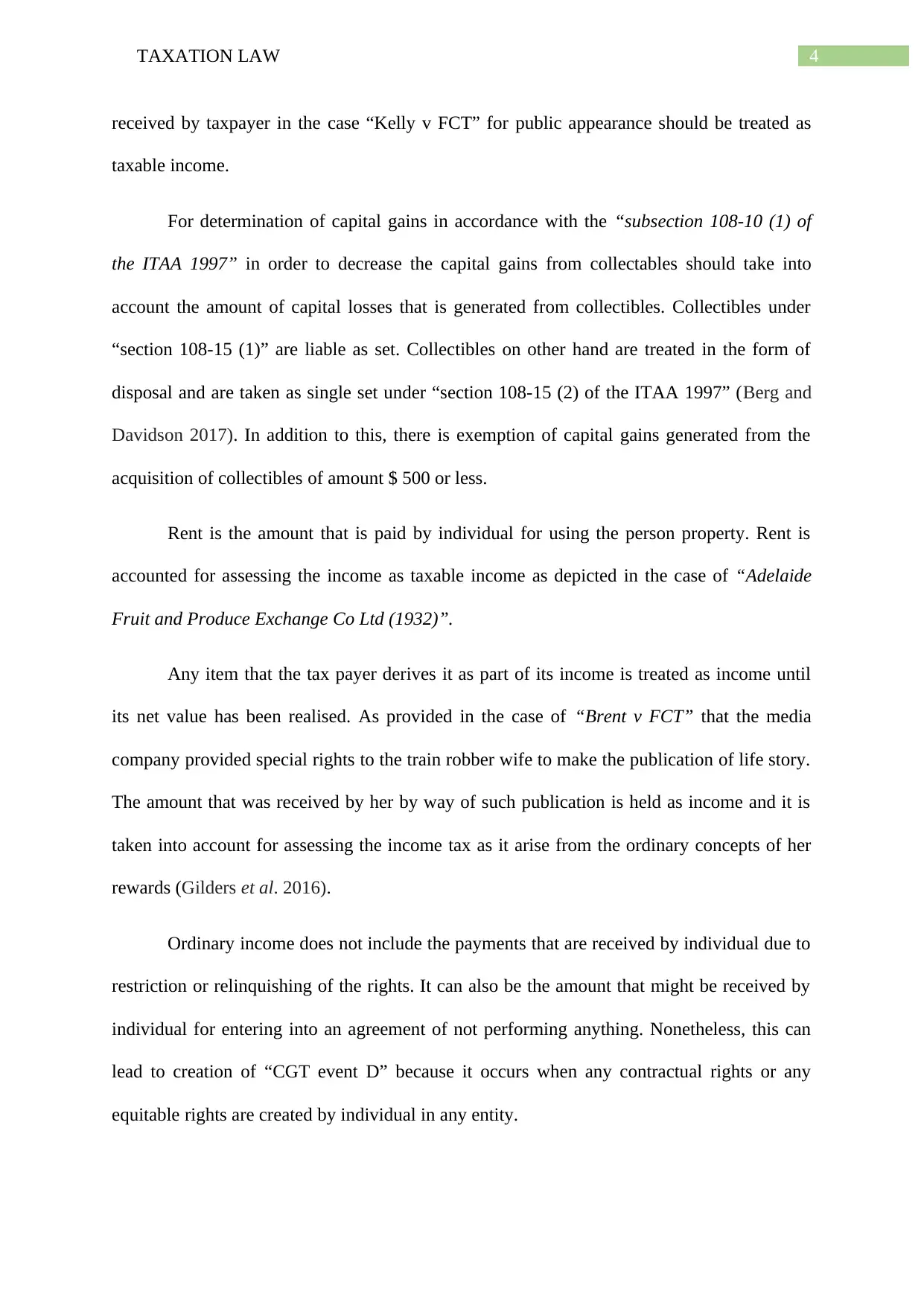
4TAXATION LAW
received by taxpayer in the case “Kelly v FCT” for public appearance should be treated as
taxable income.
For determination of capital gains in accordance with the “subsection 108-10 (1) of
the ITAA 1997” in order to decrease the capital gains from collectables should take into
account the amount of capital losses that is generated from collectibles. Collectibles under
“section 108-15 (1)” are liable as set. Collectibles on other hand are treated in the form of
disposal and are taken as single set under “section 108-15 (2) of the ITAA 1997” (Berg and
Davidson 2017). In addition to this, there is exemption of capital gains generated from the
acquisition of collectibles of amount $ 500 or less.
Rent is the amount that is paid by individual for using the person property. Rent is
accounted for assessing the income as taxable income as depicted in the case of “Adelaide
Fruit and Produce Exchange Co Ltd (1932)”.
Any item that the tax payer derives it as part of its income is treated as income until
its net value has been realised. As provided in the case of “Brent v FCT” that the media
company provided special rights to the train robber wife to make the publication of life story.
The amount that was received by her by way of such publication is held as income and it is
taken into account for assessing the income tax as it arise from the ordinary concepts of her
rewards (Gilders et al. 2016).
Ordinary income does not include the payments that are received by individual due to
restriction or relinquishing of the rights. It can also be the amount that might be received by
individual for entering into an agreement of not performing anything. Nonetheless, this can
lead to creation of “CGT event D” because it occurs when any contractual rights or any
equitable rights are created by individual in any entity.
received by taxpayer in the case “Kelly v FCT” for public appearance should be treated as
taxable income.
For determination of capital gains in accordance with the “subsection 108-10 (1) of
the ITAA 1997” in order to decrease the capital gains from collectables should take into
account the amount of capital losses that is generated from collectibles. Collectibles under
“section 108-15 (1)” are liable as set. Collectibles on other hand are treated in the form of
disposal and are taken as single set under “section 108-15 (2) of the ITAA 1997” (Berg and
Davidson 2017). In addition to this, there is exemption of capital gains generated from the
acquisition of collectibles of amount $ 500 or less.
Rent is the amount that is paid by individual for using the person property. Rent is
accounted for assessing the income as taxable income as depicted in the case of “Adelaide
Fruit and Produce Exchange Co Ltd (1932)”.
Any item that the tax payer derives it as part of its income is treated as income until
its net value has been realised. As provided in the case of “Brent v FCT” that the media
company provided special rights to the train robber wife to make the publication of life story.
The amount that was received by her by way of such publication is held as income and it is
taken into account for assessing the income tax as it arise from the ordinary concepts of her
rewards (Gilders et al. 2016).
Ordinary income does not include the payments that are received by individual due to
restriction or relinquishing of the rights. It can also be the amount that might be received by
individual for entering into an agreement of not performing anything. Nonetheless, this can
lead to creation of “CGT event D” because it occurs when any contractual rights or any
equitable rights are created by individual in any entity.
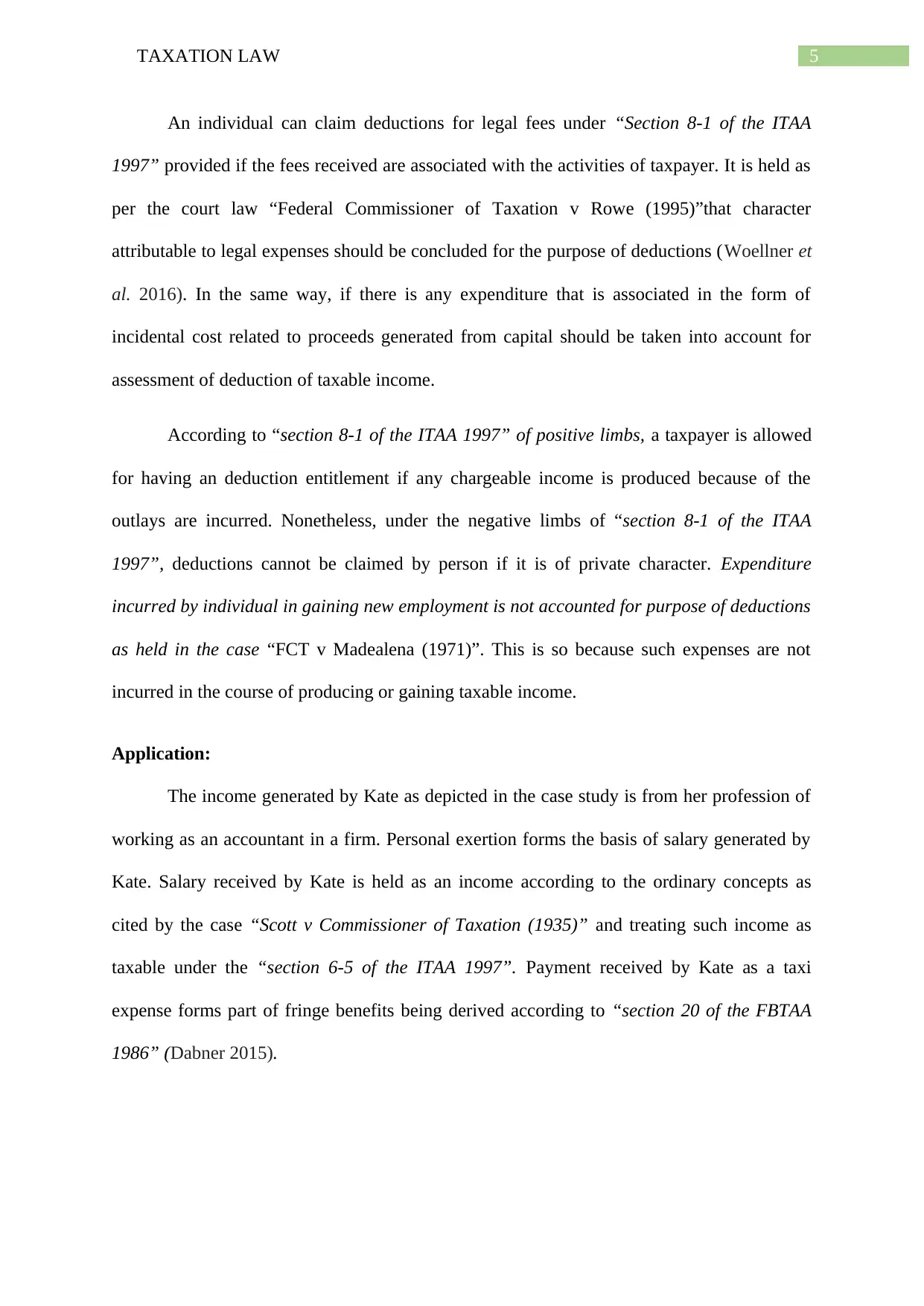
5TAXATION LAW
An individual can claim deductions for legal fees under “Section 8-1 of the ITAA
1997” provided if the fees received are associated with the activities of taxpayer. It is held as
per the court law “Federal Commissioner of Taxation v Rowe (1995)”that character
attributable to legal expenses should be concluded for the purpose of deductions (Woellner et
al. 2016). In the same way, if there is any expenditure that is associated in the form of
incidental cost related to proceeds generated from capital should be taken into account for
assessment of deduction of taxable income.
According to “section 8-1 of the ITAA 1997” of positive limbs, a taxpayer is allowed
for having an deduction entitlement if any chargeable income is produced because of the
outlays are incurred. Nonetheless, under the negative limbs of “section 8-1 of the ITAA
1997”, deductions cannot be claimed by person if it is of private character. Expenditure
incurred by individual in gaining new employment is not accounted for purpose of deductions
as held in the case “FCT v Madealena (1971)”. This is so because such expenses are not
incurred in the course of producing or gaining taxable income.
Application:
The income generated by Kate as depicted in the case study is from her profession of
working as an accountant in a firm. Personal exertion forms the basis of salary generated by
Kate. Salary received by Kate is held as an income according to the ordinary concepts as
cited by the case “Scott v Commissioner of Taxation (1935)” and treating such income as
taxable under the “section 6-5 of the ITAA 1997”. Payment received by Kate as a taxi
expense forms part of fringe benefits being derived according to “section 20 of the FBTAA
1986” (Dabner 2015).
An individual can claim deductions for legal fees under “Section 8-1 of the ITAA
1997” provided if the fees received are associated with the activities of taxpayer. It is held as
per the court law “Federal Commissioner of Taxation v Rowe (1995)”that character
attributable to legal expenses should be concluded for the purpose of deductions (Woellner et
al. 2016). In the same way, if there is any expenditure that is associated in the form of
incidental cost related to proceeds generated from capital should be taken into account for
assessment of deduction of taxable income.
According to “section 8-1 of the ITAA 1997” of positive limbs, a taxpayer is allowed
for having an deduction entitlement if any chargeable income is produced because of the
outlays are incurred. Nonetheless, under the negative limbs of “section 8-1 of the ITAA
1997”, deductions cannot be claimed by person if it is of private character. Expenditure
incurred by individual in gaining new employment is not accounted for purpose of deductions
as held in the case “FCT v Madealena (1971)”. This is so because such expenses are not
incurred in the course of producing or gaining taxable income.
Application:
The income generated by Kate as depicted in the case study is from her profession of
working as an accountant in a firm. Personal exertion forms the basis of salary generated by
Kate. Salary received by Kate is held as an income according to the ordinary concepts as
cited by the case “Scott v Commissioner of Taxation (1935)” and treating such income as
taxable under the “section 6-5 of the ITAA 1997”. Payment received by Kate as a taxi
expense forms part of fringe benefits being derived according to “section 20 of the FBTAA
1986” (Dabner 2015).
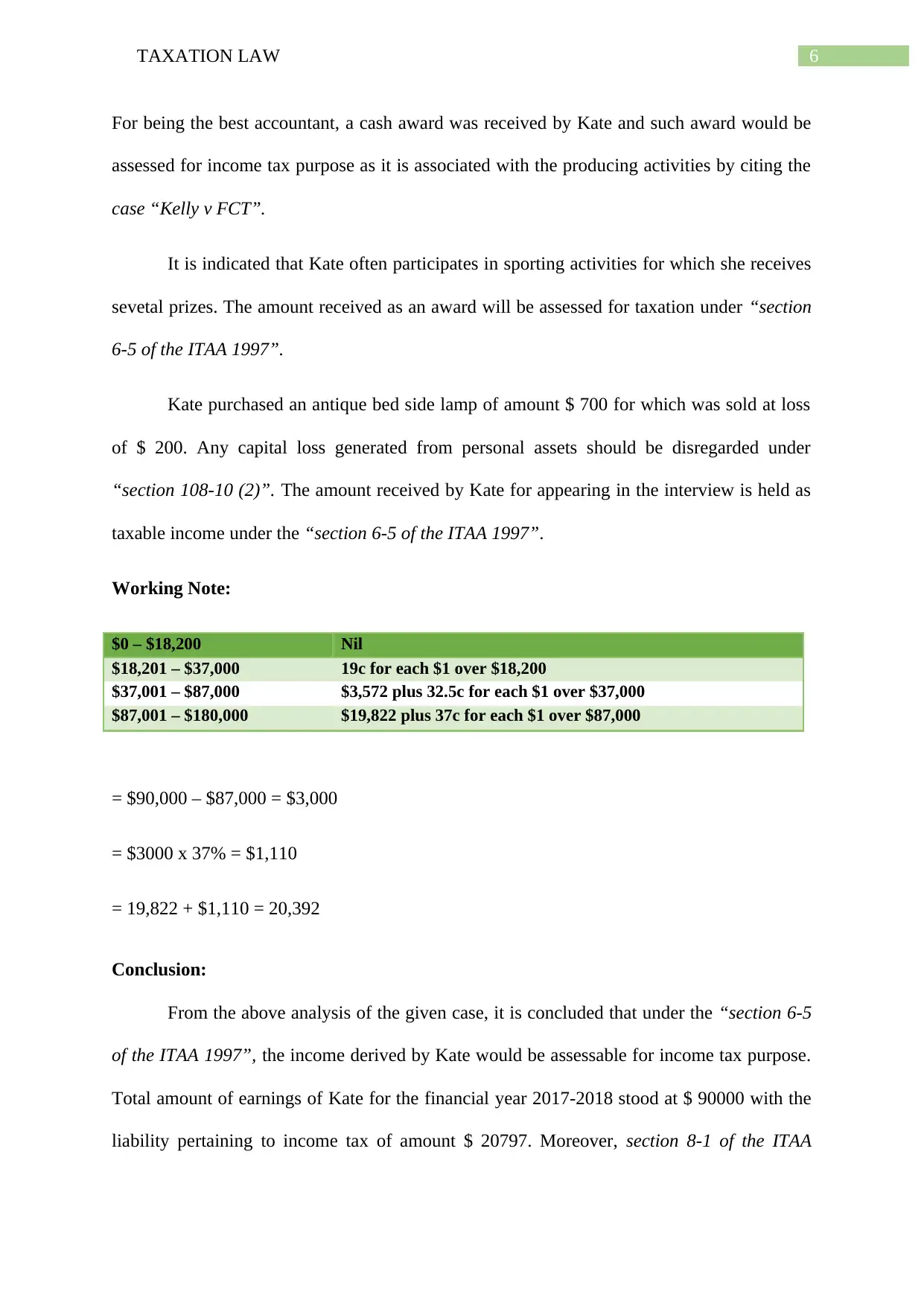
6TAXATION LAW
For being the best accountant, a cash award was received by Kate and such award would be
assessed for income tax purpose as it is associated with the producing activities by citing the
case “Kelly v FCT”.
It is indicated that Kate often participates in sporting activities for which she receives
sevetal prizes. The amount received as an award will be assessed for taxation under “section
6-5 of the ITAA 1997”.
Kate purchased an antique bed side lamp of amount $ 700 for which was sold at loss
of $ 200. Any capital loss generated from personal assets should be disregarded under
“section 108-10 (2)”. The amount received by Kate for appearing in the interview is held as
taxable income under the “section 6-5 of the ITAA 1997”.
Working Note:
$0 – $18,200 Nil
$18,201 – $37,000 19c for each $1 over $18,200
$37,001 – $87,000 $3,572 plus 32.5c for each $1 over $37,000
$87,001 – $180,000 $19,822 plus 37c for each $1 over $87,000
= $90,000 – $87,000 = $3,000
= $3000 x 37% = $1,110
= 19,822 + $1,110 = 20,392
Conclusion:
From the above analysis of the given case, it is concluded that under the “section 6-5
of the ITAA 1997”, the income derived by Kate would be assessable for income tax purpose.
Total amount of earnings of Kate for the financial year 2017-2018 stood at $ 90000 with the
liability pertaining to income tax of amount $ 20797. Moreover, section 8-1 of the ITAA
For being the best accountant, a cash award was received by Kate and such award would be
assessed for income tax purpose as it is associated with the producing activities by citing the
case “Kelly v FCT”.
It is indicated that Kate often participates in sporting activities for which she receives
sevetal prizes. The amount received as an award will be assessed for taxation under “section
6-5 of the ITAA 1997”.
Kate purchased an antique bed side lamp of amount $ 700 for which was sold at loss
of $ 200. Any capital loss generated from personal assets should be disregarded under
“section 108-10 (2)”. The amount received by Kate for appearing in the interview is held as
taxable income under the “section 6-5 of the ITAA 1997”.
Working Note:
$0 – $18,200 Nil
$18,201 – $37,000 19c for each $1 over $18,200
$37,001 – $87,000 $3,572 plus 32.5c for each $1 over $37,000
$87,001 – $180,000 $19,822 plus 37c for each $1 over $87,000
= $90,000 – $87,000 = $3,000
= $3000 x 37% = $1,110
= 19,822 + $1,110 = 20,392
Conclusion:
From the above analysis of the given case, it is concluded that under the “section 6-5
of the ITAA 1997”, the income derived by Kate would be assessable for income tax purpose.
Total amount of earnings of Kate for the financial year 2017-2018 stood at $ 90000 with the
liability pertaining to income tax of amount $ 20797. Moreover, section 8-1 of the ITAA
Paraphrase This Document
Need a fresh take? Get an instant paraphrase of this document with our AI Paraphraser
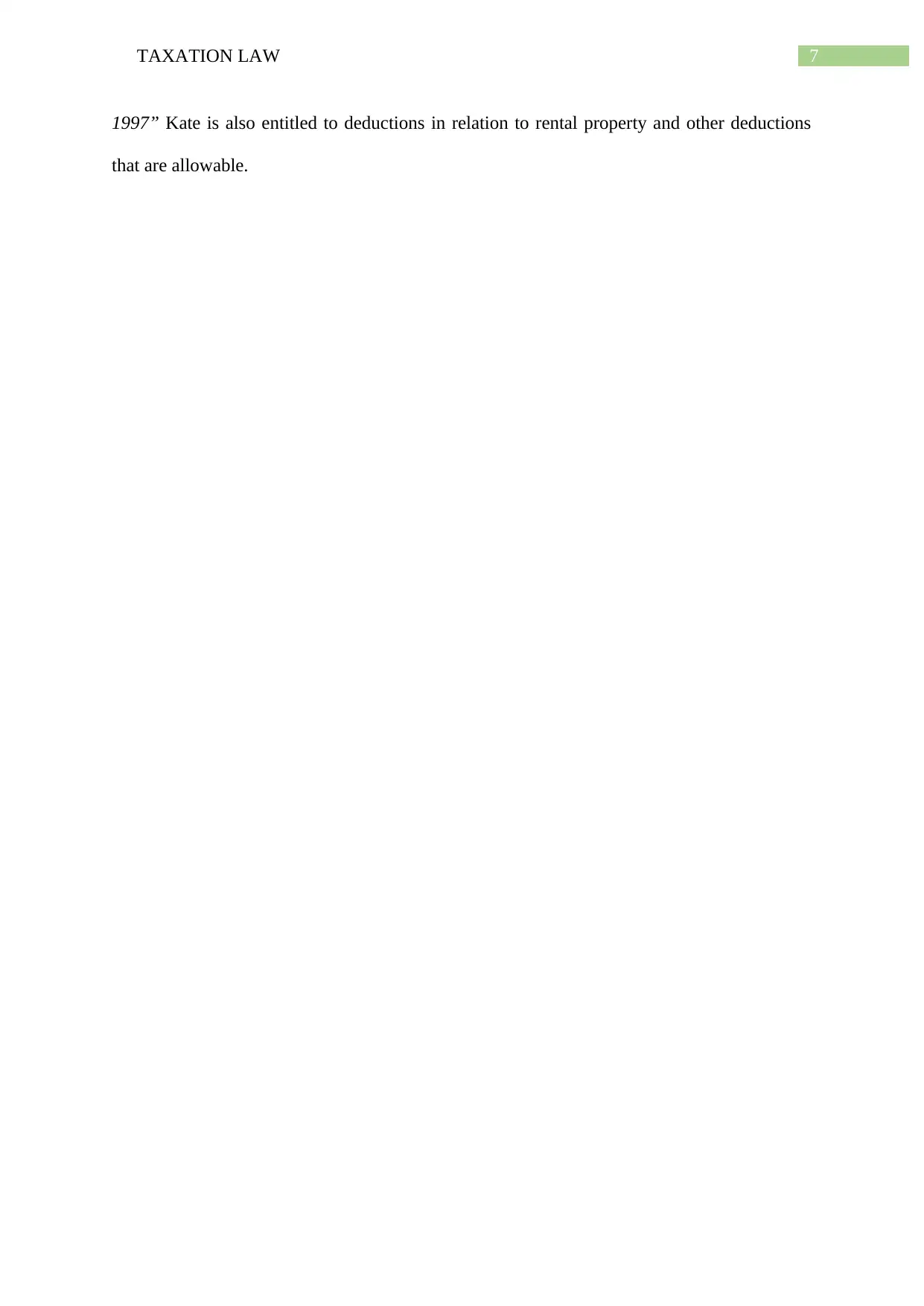
7TAXATION LAW
1997” Kate is also entitled to deductions in relation to rental property and other deductions
that are allowable.
1997” Kate is also entitled to deductions in relation to rental property and other deductions
that are allowable.
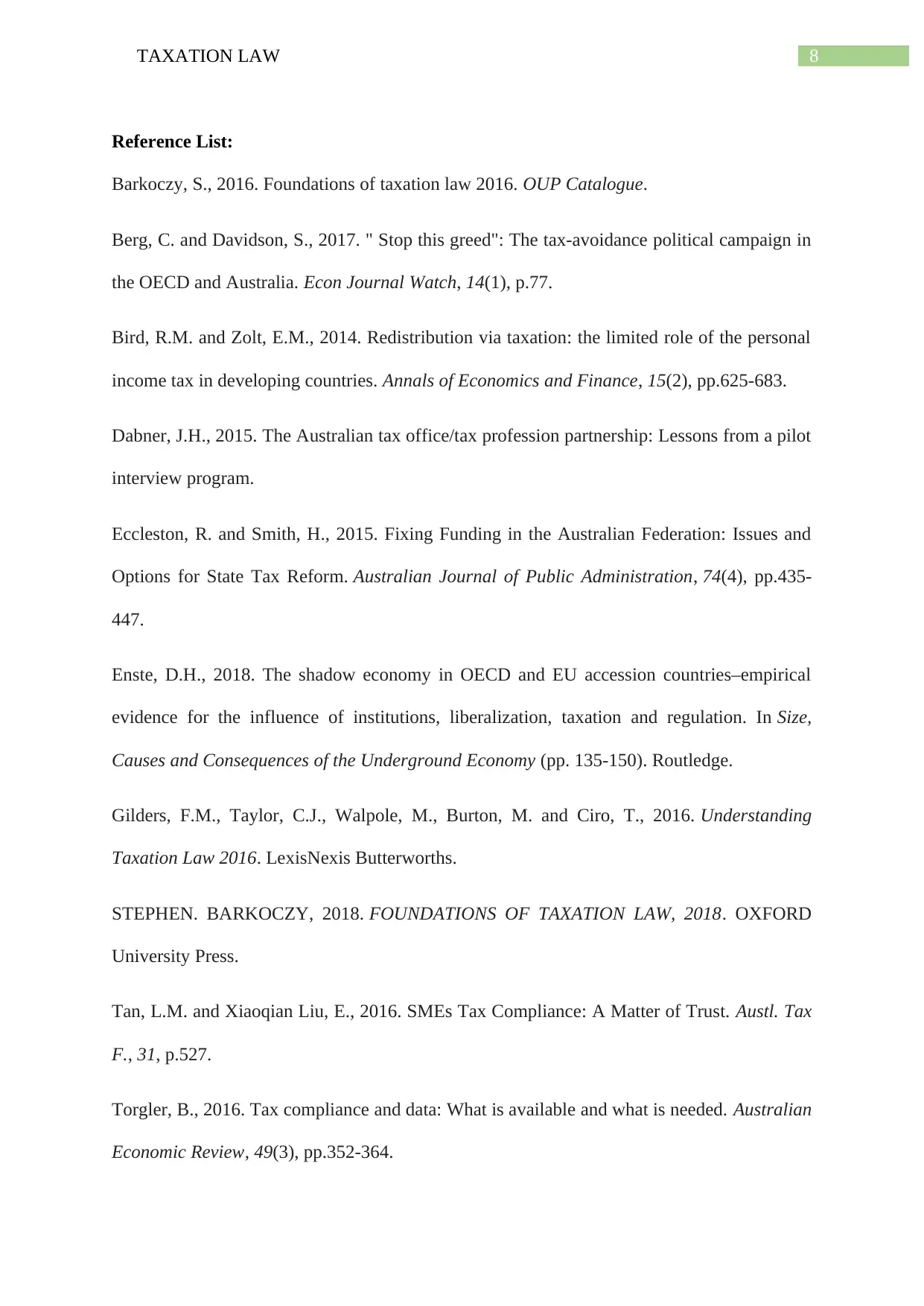
8TAXATION LAW
Reference List:
Barkoczy, S., 2016. Foundations of taxation law 2016. OUP Catalogue.
Berg, C. and Davidson, S., 2017. " Stop this greed": The tax-avoidance political campaign in
the OECD and Australia. Econ Journal Watch, 14(1), p.77.
Bird, R.M. and Zolt, E.M., 2014. Redistribution via taxation: the limited role of the personal
income tax in developing countries. Annals of Economics and Finance, 15(2), pp.625-683.
Dabner, J.H., 2015. The Australian tax office/tax profession partnership: Lessons from a pilot
interview program.
Eccleston, R. and Smith, H., 2015. Fixing Funding in the Australian Federation: Issues and
Options for State Tax Reform. Australian Journal of Public Administration, 74(4), pp.435-
447.
Enste, D.H., 2018. The shadow economy in OECD and EU accession countries–empirical
evidence for the influence of institutions, liberalization, taxation and regulation. In Size,
Causes and Consequences of the Underground Economy (pp. 135-150). Routledge.
Gilders, F.M., Taylor, C.J., Walpole, M., Burton, M. and Ciro, T., 2016. Understanding
Taxation Law 2016. LexisNexis Butterworths.
STEPHEN. BARKOCZY, 2018. FOUNDATIONS OF TAXATION LAW, 2018. OXFORD
University Press.
Tan, L.M. and Xiaoqian Liu, E., 2016. SMEs Tax Compliance: A Matter of Trust. Austl. Tax
F., 31, p.527.
Torgler, B., 2016. Tax compliance and data: What is available and what is needed. Australian
Economic Review, 49(3), pp.352-364.
Reference List:
Barkoczy, S., 2016. Foundations of taxation law 2016. OUP Catalogue.
Berg, C. and Davidson, S., 2017. " Stop this greed": The tax-avoidance political campaign in
the OECD and Australia. Econ Journal Watch, 14(1), p.77.
Bird, R.M. and Zolt, E.M., 2014. Redistribution via taxation: the limited role of the personal
income tax in developing countries. Annals of Economics and Finance, 15(2), pp.625-683.
Dabner, J.H., 2015. The Australian tax office/tax profession partnership: Lessons from a pilot
interview program.
Eccleston, R. and Smith, H., 2015. Fixing Funding in the Australian Federation: Issues and
Options for State Tax Reform. Australian Journal of Public Administration, 74(4), pp.435-
447.
Enste, D.H., 2018. The shadow economy in OECD and EU accession countries–empirical
evidence for the influence of institutions, liberalization, taxation and regulation. In Size,
Causes and Consequences of the Underground Economy (pp. 135-150). Routledge.
Gilders, F.M., Taylor, C.J., Walpole, M., Burton, M. and Ciro, T., 2016. Understanding
Taxation Law 2016. LexisNexis Butterworths.
STEPHEN. BARKOCZY, 2018. FOUNDATIONS OF TAXATION LAW, 2018. OXFORD
University Press.
Tan, L.M. and Xiaoqian Liu, E., 2016. SMEs Tax Compliance: A Matter of Trust. Austl. Tax
F., 31, p.527.
Torgler, B., 2016. Tax compliance and data: What is available and what is needed. Australian
Economic Review, 49(3), pp.352-364.
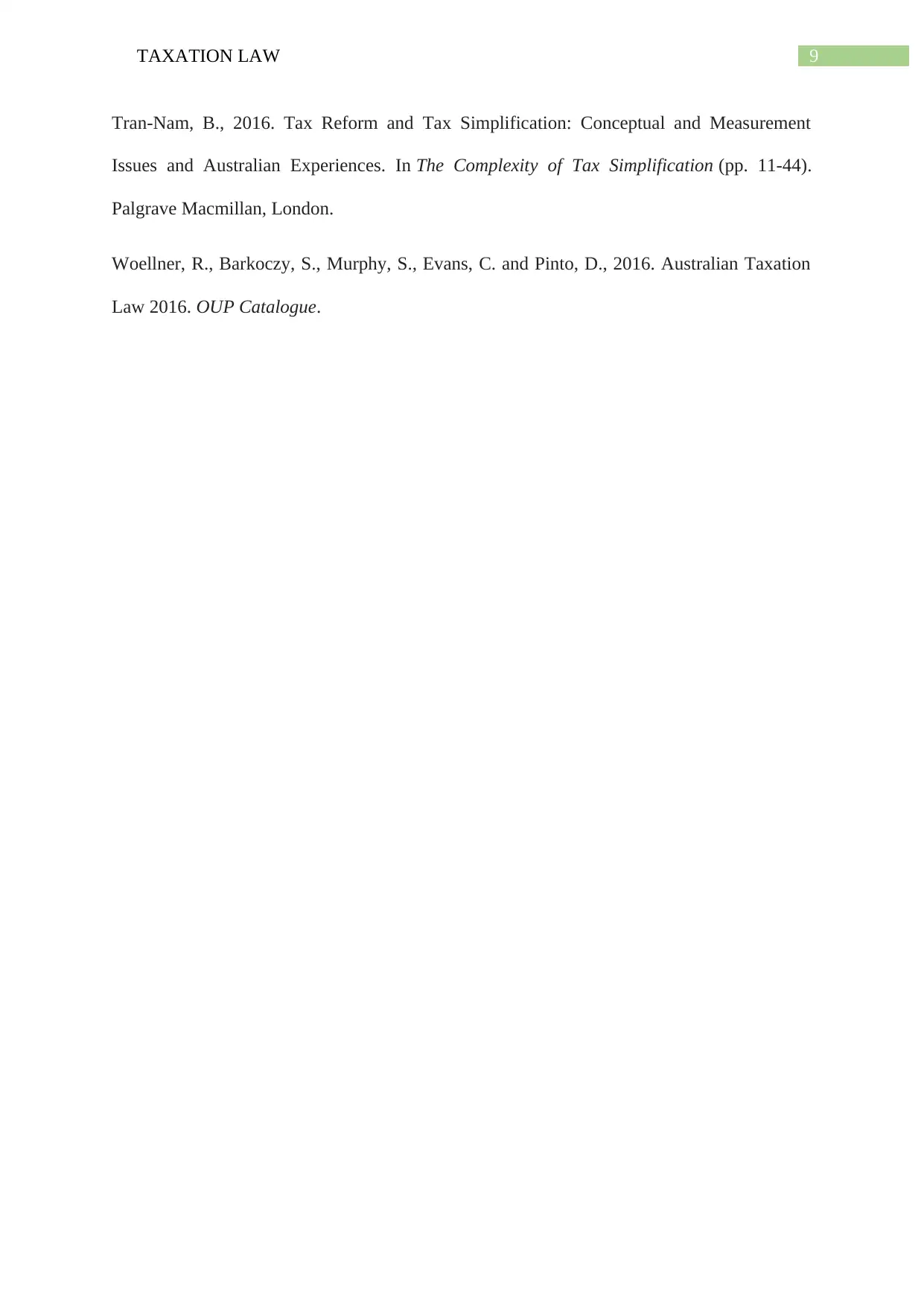
9TAXATION LAW
Tran-Nam, B., 2016. Tax Reform and Tax Simplification: Conceptual and Measurement
Issues and Australian Experiences. In The Complexity of Tax Simplification (pp. 11-44).
Palgrave Macmillan, London.
Woellner, R., Barkoczy, S., Murphy, S., Evans, C. and Pinto, D., 2016. Australian Taxation
Law 2016. OUP Catalogue.
Tran-Nam, B., 2016. Tax Reform and Tax Simplification: Conceptual and Measurement
Issues and Australian Experiences. In The Complexity of Tax Simplification (pp. 11-44).
Palgrave Macmillan, London.
Woellner, R., Barkoczy, S., Murphy, S., Evans, C. and Pinto, D., 2016. Australian Taxation
Law 2016. OUP Catalogue.
Secure Best Marks with AI Grader
Need help grading? Try our AI Grader for instant feedback on your assignments.

10TAXATION LAW
1 out of 11
Related Documents
Your All-in-One AI-Powered Toolkit for Academic Success.
+13062052269
info@desklib.com
Available 24*7 on WhatsApp / Email
![[object Object]](/_next/static/media/star-bottom.7253800d.svg)
Unlock your academic potential
© 2024 | Zucol Services PVT LTD | All rights reserved.





